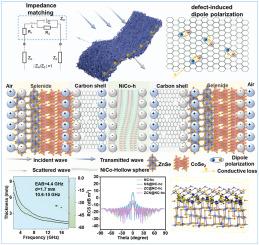多硒化改性碳纤维构建非均相界面的电磁波吸收
IF 11.6
2区 材料科学
Q1 CHEMISTRY, PHYSICAL
引用次数: 0
摘要
多组分界面工程为高效电磁波(EMW)吸收提供了巨大的潜力,但精确的界面调制仍然具有挑战性。在这里,我们通过实验合成和密度泛函理论(DFT)指导的界面设计来定制mof衍生的核壳异质结构中的EMW吸收。通过静电纺丝、水热法和热还原法制备了三种硒化物复合材料。通过结合NiCo导电网络和碳纳米纤维电子高速公路,设计了分层界面。DFT模拟定量验证了ZnSe/CoSe2连接处界面诱导的极化弛豫增强。结果表明,具有丰富非均相界面的ZnSe/CoSe2/Ni@NiCo-hc复合材料在7 wt%的低填充量下表现出优异的EMW吸收性能。在优化匹配厚度为1.8 mm时,反射损耗最小为−57.28 dB。出色的吸收性能可在广泛的频率范围内调谐。雷达截面(RCS)仿真结果表明,三种硒化物复合材料具有良好的电磁隐身性能。本文提出了通过合理的异质界面工程设计高性能EMW吸波器的有效策略。本文章由计算机程序翻译,如有差异,请以英文原文为准。

Multiple selenide modified carbon fibers to construct heterogeneous interfaces for electromagnetic wave absorption
Multi-component interface engineering offers significant potential for high-efficiency electromagnetic wave (EMW) absorption, yet precise interfacial modulation remains challenging. Here, we tailor EMW absorption in MOF-derived core-shell heterostructures via experimental synthesis and Density Functional Theory (DFT)-guided interface design. Three selenide composites were fabricated through electrospinning, hydrothermal processing, and thermal reduction. By incorporating NiCo conductive networks and carbon nanofiber electron highways, hierarchical interfaces were engineered. DFT simulations quantitatively validate enhanced interface-induced polarization relaxation at ZnSe/CoSe2 junctions. As a result, the ZnSe/CoSe2/Ni@NiCo-hc composite, with abundant heterogeneous interfaces, exhibited exceptional EMW absorption performance at a low filler loading of 7 wt%. At an optimized matching thickness of 1.8 mm, a minimum reflection loss of −57.28 dB was achieved. Outstanding absorption performance tunable across a broad frequency range. In addition, the radar cross section (RCS) simulation demonstrated that the three selenide composites possessed excellent electromagnetic stealth capabilities. This work presents an effective strategy for designing high-performance EMW absorbers through rational heterointerface engineering.
求助全文
通过发布文献求助,成功后即可免费获取论文全文。
去求助
来源期刊

Carbon
工程技术-材料科学:综合
CiteScore
20.80
自引率
7.30%
发文量
0
审稿时长
23 days
期刊介绍:
The journal Carbon is an international multidisciplinary forum for communicating scientific advances in the field of carbon materials. It reports new findings related to the formation, structure, properties, behaviors, and technological applications of carbons. Carbons are a broad class of ordered or disordered solid phases composed primarily of elemental carbon, including but not limited to carbon black, carbon fibers and filaments, carbon nanotubes, diamond and diamond-like carbon, fullerenes, glassy carbon, graphite, graphene, graphene-oxide, porous carbons, pyrolytic carbon, and other sp2 and non-sp2 hybridized carbon systems. Carbon is the companion title to the open access journal Carbon Trends. Relevant application areas for carbon materials include biology and medicine, catalysis, electronic, optoelectronic, spintronic, high-frequency, and photonic devices, energy storage and conversion systems, environmental applications and water treatment, smart materials and systems, and structural and thermal applications.
 求助内容:
求助内容: 应助结果提醒方式:
应助结果提醒方式:


